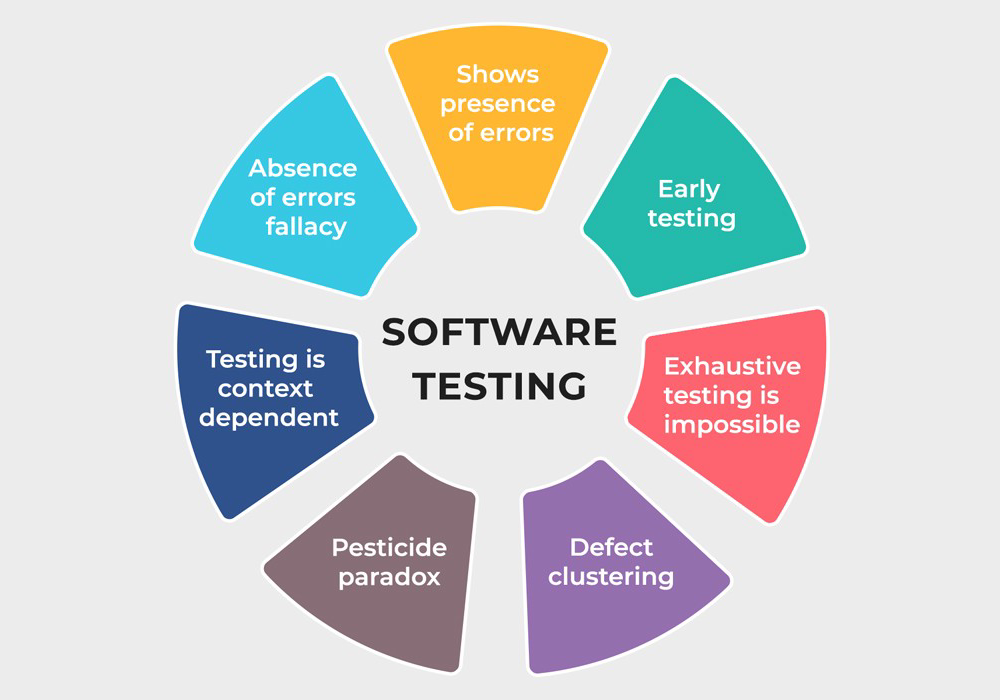Software testing is the act of examining the artifacts and the behavior of the software under test by validation and verification. Software testing can also provide an objective, independent view of the software to allow the business to appreciate and understand the risks of software implementation.

What is Software Engineering ?
- Software engineering is a systematic engineering approach to software development.
- Software engineering is a detailed study of engineering to the design, development and maintenance of software.
- Software engineering was introduced to address the issues of low-quality software projects. .
What is Software Testing ?
Software testing is the process of evaluating and verifying that a software product or application does what it is supposed to do. The benefits of testing include preventing bugs, reducing development costs and improving performance.
Why are Software Testing principles important?
Testing helps greatly reduce the number of undiscovered defects hiding in software, but finding and resolving these issues is not itself proof that the software or system is 100% issue-free. This concept should always be accepted by teams, and effort should be made to manage client expectations.
Test principles will help you draft error-catching test cases and create an effective Test Strategy. Software testing is governed by the following seven principles:
- Testing shows the presence of defects
- Exhaustive testing is not possible
- Early testing
- Defect clustering
- Pesticide paradox
- Testing is context dependent
- Absence of errors fallacy
Now, what are these principles of software testing? Let’s take a look at the 7 Software Testing Principles curated for you.
7 Principles of Software Testing – Software Engineering
1.Testing shows the presence of defects
The goal of software testing is to make the software fail. Software testing reduces the presence of defects. Software testing talks about the presence of defects and doesn’t talk about the absence of defects. Software testing talks about the presence of defects and doesn’t talk about the absence of defects. Software testing can ensure that defects are present but it can not prove that software is defect-free. Even multiple testing can never ensure that software is 100% bug-free. Testing can reduce the number of defects but not remove all defects.
2.Exhaustive testing is not possible
Exhaustive testing may sometimes not be possible practically while carrying out testing. This can be because the total number of possible combinations is too big, and it is not computationally feasible to test all of them.
Exhaustive testing tests all possible scenarios. A program rarely passes all of them. However, some bugs might occur rarely and are therefore termed as low-priority bugs. Other bugs might occur for a certain population of users only. Exhaustive testing provides a bigger picture of all the possible scenarios that can arise within a program. A program that passes an exhaustive test is robust and able to handle all situations.
3.Early testing
Software testing should start early in the Software Development Life Cycle. This helps to capture and eliminate defects in the early stages of SDLC i.e requirement gathering and design phases. An early start to testing helps to reduce the number of defects and ultimately the rework cost in the end.
4.Defect clustering
Bugs are not often distributed evenly throughout an application. Defect clustering simply means that a small number of features have caused the majority of quality issues in an application.
A range of culprits may be responsible for defect clustering, from legacy code prone to breaking, to newer features that are undergoing frequent changes, to a particularly fickle 3rd-party integration. Whatever the reason, the ability to identify defect-prone areas of your product is an essential.
5.Pesticide paradox
Repeating the same test cases, again and again, will not find new bugs. So it is necessary to review the test cases and add or update test cases to find new bugs.
6.Testing is context dependent
Testing is a context-dependent principle states that we have multiple fields such as e-commerce websites, commercial websites, and so on are available in the market. There is a definite way to test the commercial site as well as the e-commerce websites because every application has its own needs, features, and functionality. To check this type of application, we will take the help of various kinds of testing, different technique, approaches, and multiple methods. Therefore, the testing depends on the context of the application.
7.Absence of errors fallacy
This principle encourages the tester to validate whether or not the application is meeting the user requirements.
In other words, it really makes no sense to find and fix errors of an application that is not even meeting the user’s perspective. It will all be just a waste. Therefore, we should always first examine the potential of an application.
It is pretty likely that the application, which is 99% bug-free, may still be unusable. This can be the case if the application is tested thoroughly for the wrong requirement.
So testing is not merely finding defects but also ensuring that the application addresses the business needs. All in all, the absence of error is a fallacy, i.e., detecting and fixing defects does not really help if the application is unusable and does not meet the user’s requirements.
How many principles of software testing are there?
There are seven principles in software testing
What is meant by software testing?
Software testing is the process of evaluating and verifying that a software product or application does what it is supposed to do. The benefits of testing include preventing bugs, reducing development costs and improving performance.
What is a salary of a software engineer?
A mid-career Software Engineer with 4-9 years of experience earns an average salary of ₹8.9 Lakhs per year, while an experienced Software Engineer with 10-20 years of experience earns an average salary of ₹19.2 Lakhs per year.


